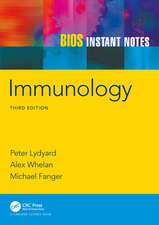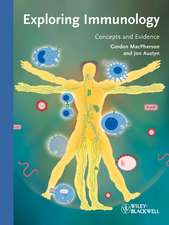Biological Amplification Systems in Immunology: Comprehensive Immunology, cartea 2
Editat de N. Dayen Limba Engleză Paperback – 22 mar 2012
Preț: 376.06 lei
Preț vechi: 395.85 lei
-5% Nou
Puncte Express: 564
Preț estimativ în valută:
71.96€ • 75.13$ • 59.56£
71.96€ • 75.13$ • 59.56£
Carte tipărită la comandă
Livrare economică 04-18 aprilie
Preluare comenzi: 021 569.72.76
Specificații
ISBN-13: 9781468425468
ISBN-10: 1468425463
Pagini: 344
Ilustrații: XVI, 325 p. 13 illus.
Dimensiuni: 178 x 254 x 18 mm
Greutate: 0.6 kg
Ediția:Softcover reprint of the original 1st ed. 1977
Editura: Springer Us
Colecția Springer
Seria Comprehensive Immunology
Locul publicării:New York, NY, United States
ISBN-10: 1468425463
Pagini: 344
Ilustrații: XVI, 325 p. 13 illus.
Dimensiuni: 178 x 254 x 18 mm
Greutate: 0.6 kg
Ediția:Softcover reprint of the original 1st ed. 1977
Editura: Springer Us
Colecția Springer
Seria Comprehensive Immunology
Locul publicării:New York, NY, United States
Public țintă
ResearchCuprins
1 Biochemistry and Biology of Complement Activation.- 1. Introduction.- 2. Biochemistry of Complement Activation.- 3. Regulation Mechanisms of the Complement Reaction.- 4. Biological Activities Generated during Complement Activation.- 5. Conclusion.- References.- 2 Alternative Modes and Pathways of Complement Activation.- 1. Introduction.- 2. Activation by Agents Not Components of ? Nor Acting as Antigens.- 3. The Alternative or Properdin Pathway of ? Activation.- 4. Initiation of the ? Sequence by Heterotopically Activated Complement Components.- 5. Summary.- References.- 3 Complement Synthesis.- 1. Introduction.- 2. Methods for Studies of Complement Synthesis.- 3. Sites of Synthesis of Complement Components.- 4. Genetic Regulation of Complement Synthesis.- 5. Nongenetic Control of Complement Biosynthesis.- 6. Conclusion.- References.- 4 Plasma Membrane Receptors for Complement.- 1. Introduction.- 2. Definitions and Nomenclature.- 3. Molecular Structure of C3 and C4.- 4. Complement Receptors.- 5. Reagents for the Detection of b and d Receptors.- 6. Cells Bearing Plasma Membrane Receptors for Complement.- 7. Functional Significance of the Receptors for Complement.- 8. Conclusion.- References.- 5 Opsonization.- 1. Introduction.- 2. Immunoglobulin G.- 3. Complement.- 4. Other Opsonins.- 5. Cytophilic Antibody.- 6. Intracellular Effects of Opsonins.- 7. Mechanism of Action of Opsonins in the Ingestion Phase of Phagocytosis.- 8. Conclusions.- References.- 6 Killing of Nucleated Cells by Antibody and Complement.- 1. Introduction.- 2. Role of Antigen, Antibody, and ? in the Killing of Nucleated Cells.- 3. Role of Cell Repair of ? Damage or Inhibition of ? Action.- 4. Summary.- References.- 7 Serum Bactericidal Activity and Complement.- 1. General Considerations.- 2.Methodology.- 3. Immune Hemolysis: An Analogous Process.- 4. Insensitivity of Gram-Positive Organisms and Mycobacteria.- 5. Anatomy of the Gram-Negative Bacterial Cell: Its Relationship to the Cell’s Complement and Lysozyme Sensitivity.- 6. Antigenic Targets of the Bactericidal Reaction.- 7. Sensitivity Differences between Rough and Smooth Strains.- 8. Antibody Source.- 9. Complement Source.- 10. Interactions of the Immune Bactericidal Reaction.- 11. Role of the Immune Bactericidal Reaction in Gram-Negative Bacterial Infections.- 12. Summary.- References.- 8 Biologic Aspects of Leukocyte Chemotaxis.- 1. Introduction.- 2. Methods for Quantifying Leukocyte Chemotaxis in Vitro.- 3. Chemotactic Factors.- 4. Defective Chemotaxis in Human Disease.- 5. Summary and Conclusions.- References.- 9 Phylogenetics and Ontogenetics of the Complement Systems.- 1. Introduction.- 2. Ontogeny of the Human Complement System.- 3. Ontogenetic Study of Complement in Animals.- 4. Phylogeny of the ? System.- 5. Humoral Immunity, Cellular Immunity, and Complement in Phylogenetic Perspective.- 6. Summary.- References.- 10 The Chemistry and Biology of the Proteins of the Hageman Factor-Activated Pathways.- 1. Introduction.- 2. Biochemical Properties of the Components of the Hageman Factor-Activated Pathways.- 3. Regulation of the Activation of Hageman Factor—Reciprocal Activation.- 4 Biological Activities Associated with the Activated Components of the Hageman Factor Pathways.- 5. Participation of the Hageman Factor Pathways in Experimental and Human Disease.- 6. Summary.- References.- 11 Isolated Deficiencies of the Complement System in Experimental Animals.- 1. Introduction.- 2. C1 Deficiency in Chickens.- 3. C4 Deficiency.- 4. “C3” Deficiency in Guinea Pigs.- 5. C5 Deficiency in Mice.-6. C6 Deficiency.- 7. Conclusion.- References.- 12 Inherited Deficiencies of the Complement System.- 1. Introduction.- 2. Clq Deficiency in Man.- 3. Clr Deficiency in Man.- 4. Deficiency of Cls Inhibitor.- 5. Hereditary Cls Deficiency.- 6. Hereditary C2 Deficiency.- 7. Hereditary C3 Deficiency.- 8. Deficiency of C3b Inactivator.- 9. Hereditary C4 Deficiency.- 10. C5 Dysfunction.- 11. Hereditary C5 Deficiency.- 12. Hereditary C6 Deficiency.- 13. Hereditary C7 Deficiency.- 14. Hereditary C8 Deficiency.- 15. Conclusion.- References.- 13 Complement and the Major Histocompatibility Systems.- 1. Introduction.- 2. Major Histocompatibility Systems.- 3. Evidence of Genetic Association between the H and ? Systems.- 4. Conclusions.- References.- 14 Complement in Cancer.- 1. Introduction.- 2. Complement in Tumor-Bearing Animals.- 3. Complement in AKR Leukemia.- 4. Feline and Canine Lymphosarcomas (Leukemias).- 5. Complement Levels in Human Cancer.- 6. Complement and Therapy.- 7. Conclusion.- References.- 15 Perturbations of Complement in Disease.- 1. Introduction.- 2. Acquired Abnormalities.- 3. Genetic Abnormalities.- References.- Abbreviations.- Inde.


















